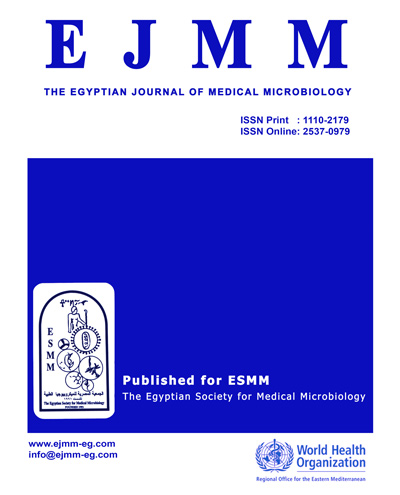ABSTRACT
Background: Surgical site infections (SSI) are the most common nosocomial infections in surgical patients and lead to prolonged hospital stay, readmission to the hospital, and increased morbidity and mortality. Objectives: This study aimed to detect the incidence of SSI and the risk factors, the causative organisms and their antimicrobial susceptibility pattern in general surgery department at Sohag university hospital. Methodology: A prospective SSI surveillance at Sohag University hospital from (January 2017 to June 2017) using the criteria of the Centers for Disease Control. Basic demographic, surgical data and data of possible risk factors were collected from all patients. Patients were followed up for 30 days after surgery. Swabs were collected from cases with signs and symptoms of SSI and cultured on basic microbiological culture media. Isolated colonies were identified microscopically and biochemically. Full identification of the causative organisms and their antibiotic sensitivity were done by Vitek 2 compact automated system. Results: The study included 482 patients and the incidence of SSI infections was (11.2%). Escherichia coli was the most common organism causing SSI and was responsible for (40%) of SSIs followed by Pseudomonas aeruginosa (20%), Staphylococcus aureus (20%), Enterobacter cloacae (10 %) and Klebsiella pneumoniae (10 %). Most of isolated E. coli and Klebsiella were ESBL producers (73.3%). Pseudomonas aeruginosa shows emergence of resistance to tigecycline (25%). All isolated staph. aureus were (MRSA) and (10%) of them were (VRSA). Univariate regression analysis show that older age, urgent operation type, bad patient general condition, contaminated wound type, hypertension, obesity, intake of antibiotic prophylaxis and increased length of hospital stay (days) were risk factors for SSI. The multivariable regression analysis revealed that urgent operations type, bad patient condition, obesity increasing length of hospital stay (days) and intake of antibiotic prophylaxis independent risk factors for the development of a SSI. Conclusion: The study provides a valuable data about SSI in General Surgery Department and highlights risk factors associated with SSI, the causative pathogens and their antibiotic sensitivity in our hospital that can help in updating the antimicrobial prophylaxis policy and reducing the incidence of SSI


